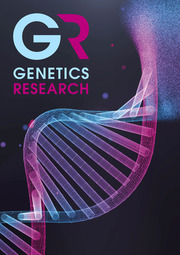Crossref Citations
This article has been cited by the following publications. This list is generated based on data provided by
Crossref.
Sharp, Gillian L.
Hill, William G.
and
Robertson, Alan
1984.
Effects of selection on growth, body composition and food intake in mice I. Responses in selected traits.
Genetical Research,
Vol. 43,
Issue. 1,
p.
75.
Lynch, Carol Becker
and
Roberts, R. C.
1984.
Aspects of temperature regulation in mice selected for large and small size.
Genetical Research,
Vol. 43,
Issue. 3,
p.
299.
Mgheni, M.
and
Christensen, K.
1985.
Selection Experiment on Growth and Litter Size in Rabbits.
Acta Agriculturae Scandinavica,
Vol. 35,
Issue. 3,
p.
278.
1986.
Protein turnover, physiological energetics and heterozygosity in the blue mussel,
Mytilus edulis
: the basis of variable age-specific growth
.
Proceedings of the Royal Society of London. Series B. Biological Sciences,
Vol. 229,
Issue. 1255,
p.
161.
Bernier, Jean F.
Calvert, C. Chris
Famula, Thomas R.
and
Baldwin, R. Lee
1986.
Maintenance Energy Requirement and Net Energetic Efficiency in Mice with a Major Gene for Rapid Postweaning Gain.
The Journal of Nutrition,
Vol. 116,
Issue. 3,
p.
419.
Snow, Michael H. L.
1986.
Human Growth.
p.
67.
Toyomizu, Masaaki
Hayashi, Kunioki
Yamashita, Koichi
and
Tomita, Yuichiro
1988.
Response Surface Analyses of the Effects of Dietary Protein on Feeding and Growth Patterns in Mice from Weaning to Maturity.
The Journal of Nutrition,
Vol. 118,
Issue. 1,
p.
86.
Noordwijk, A. J. Van
Balen, J. H. Van
and
Scharloo, W.
1988.
Heritability of body size in a natural population of the Great Tit (Parus major) and its relation to age and environmental conditions during growth.
Genetical Research,
Vol. 51,
Issue. 2,
p.
149.
Urrutia, M. S.
and
Hayes, J. F.
1988.
Selection for weight gain in mice at two ages and under ad libitum and restricted feeding.
Theoretical and Applied Genetics,
Vol. 75,
Issue. 3,
p.
424.
Snow, M. H. L.
1989.
Fetal Growth.
p.
3.
Prasetyo, H.
and
Eisen, E. J.
1989.
Correlated responses in development and distribution of fat depots in mice selected for body composition traits.
Theoretical and Applied Genetics,
Vol. 78,
Issue. 2,
p.
217.
KOEHN, RICHARD K.
1991.
The cost of enzyme synthesis in the genetics of energy balance and physiological performance.
Biological Journal of the Linnean Society,
Vol. 44,
Issue. 3,
p.
231.
O'SULLIVAN, N.P.
DUNNINGTON, E.A.
and
SIEGEL, P.B.
1992.
Correlated Responses in Lines of Chickens Divergently Selected for Fifty-Six–Day Body Weight..
Poultry Science,
Vol. 71,
Issue. 4,
p.
590.
Moride, Y.
and
Hayes, J. F.
1993.
Correlated responses in growth hormone to selection for weight gain in mice.
Journal of Animal Breeding and Genetics,
Vol. 110,
Issue. 1-6,
p.
450.
Kajiura, Lovaye J.
and
Rollo, C. David
1996.
The ontogeny of resource allocation in giant transgenic rat growth hormone mice.
Canadian Journal of Zoology,
Vol. 74,
Issue. 3,
p.
492.
Rollo, C D
Kajiura, L J
Wylie, B
and
D'Souza, S
1999.
The growth hormone axis, feeding, and central allocative regulation: lessons from giant transgenic growth hormone mice.
Canadian Journal of Zoology,
Vol. 77,
Issue. 12,
p.
1861.
HOOPER, A. C. B.
BRIEN, T. G.
and
LAWLOR, P. G.
2009.
The Effects of Orchidectomy and the Role of Testosterone in Determining the Growth of Male Mice Selected for Increased Body Weight.
Andrologia,
Vol. 18,
Issue. 5,
p.
509.
2013.
Behavioral Genetics of the Mouse.
p.
205.
Bult-Ito, Abel
2013.
Behavioral Genetics of the Mouse.
p.
230.
Lankin, V. S.
Nikitin, S. V.
and
Trapezov, O. V.
2016.
Factors contributing to the variation of the fearful withdrawal response to humans in minipigs bred at ICG SB RAS.
Russian Journal of Genetics: Applied Research,
Vol. 6,
Issue. 5,
p.
594.




